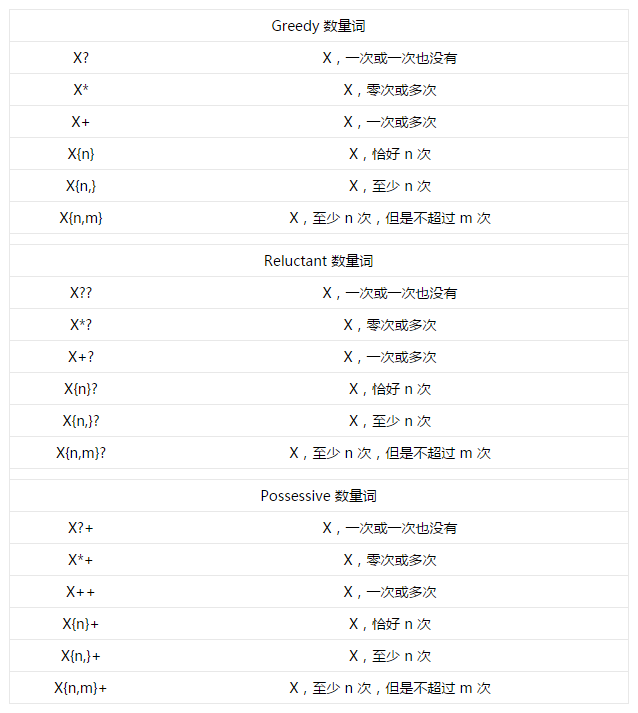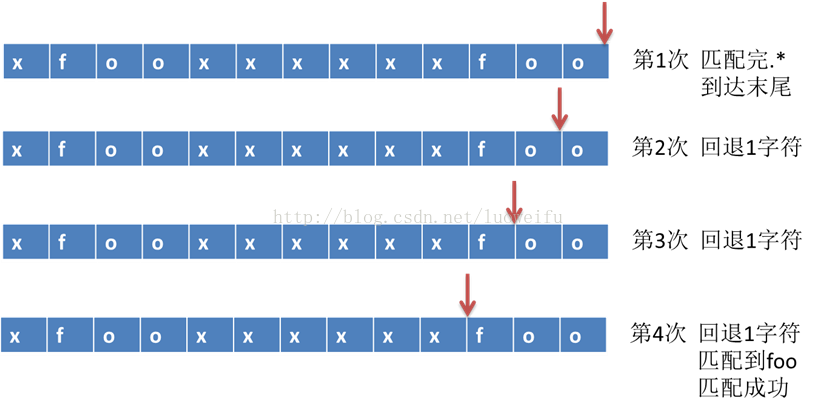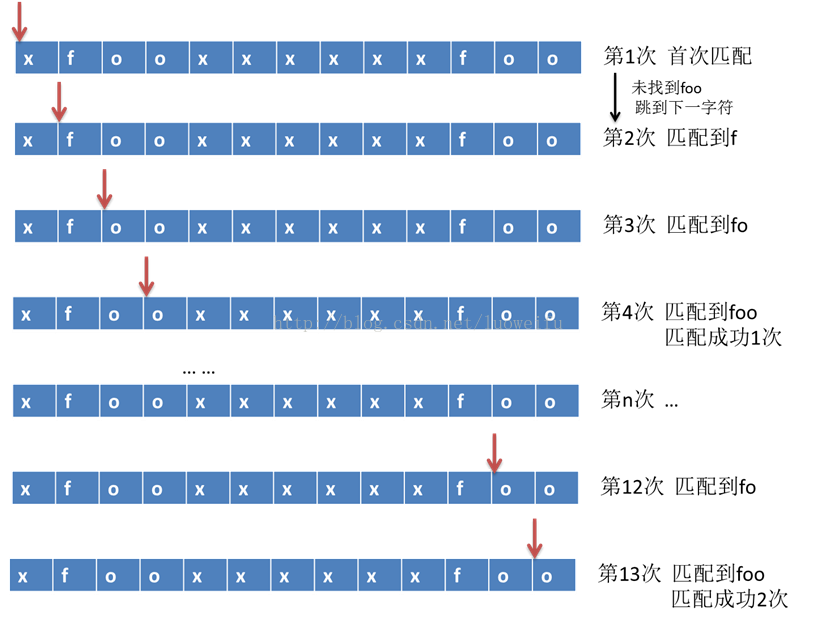
Greedy、Reluctant、Possessive的区别
实例说话
看上面的表格我们发现这三种数量词的含意都相同(如X?、X??、X?+都表示一次或一次也没有),但他们之间还是有一些细微的区别的。我们先来看一个例子:
1.Greedy
public static void testGreedy() {
Pattern p = Pattern.compile(".*foo");
String strText = "xfooxxxxxxfoo";
Matcher m = p.matcher(strText);
while (m.find()) {
System.out.println("matched form " + m.start() + " to " + m.end());
}
}结果:
matched form 0 to 13
2.Reluctant
public static void testReluctant() {
Pattern p = Pattern.compile(".*?foo");
String strText = "xfooxxxxxxfoo";
Matcher m = p.matcher(strText);
while (m.find()) {
System.out.println("matched form " + m.start() + " to " + m.end());
}
}结果:
matched form 0 to 4
matched form 4 to 13
3.Possessive
public static void testPossessive() {
Pattern p = Pattern.compile(".*+foo");
String strText = "xfooxxxxxxfoo";
Matcher m = p.matcher(strText);
while (m.find()) {
System.out.println("matched form " + m.start() + " to " + m.end());
}
}结果:
//未匹配成功
原理讲解
Greedy数量词被称为“贪婪的”是因为匹配器被强制要求第一次尝试匹配时读入整个输入串,如果第一次尝试匹配失败,则从后往前逐个字符地回退并尝试再次匹配,直到匹配成功或没有字符可回退。
模式串:.*foo
查找串:xfooxxxxxxfoo
结果:matched form 0 to 13
其比较过程如下

Reluctant采用与Greedy相反的方法,它从输入串的首(字符)位置开始,在一次尝试匹配查找中只勉强地读一个字符,直到尝试完整个字符串。
模式串:.*foo
查找串:xfooxxxxxxfoo
结果:matched form 0 to 4
matched form 4 to 13
其比较过程如下

Possessive数量词总是读入整个输入串,尝试一次(仅且一次)匹配成功,不像Greedy,Possessive从不回退,即便这样做也可能使整体匹配成功。
模式串:.*foo
查找串:xfooxxxxxxfoo
结果:
//未匹配成功
其比较过程如下

参考文章:http://docs.oracle.com/javase/tutorial/essential/regex/quant.html
再来看看几个例子:
模式串:.+[0-9]
查找串:abcd5aabb6
结果:matched form 0 to 10
模式串:.+?[0-9]
查找串:abcd5aabb6
结果:matched form 0 to 4
模式串:.{1,9}+[0-9]
查找串:abcd5aabb6
结果:matched form 0 to 10
模式串:.{1,10}+[0-9]
查找串:abcd5aabb6
结果:匹配失败

热AI工具

Undresser.AI Undress
人工智能驱动的应用程序,用于创建逼真的裸体照片

AI Clothes Remover
用于从照片中去除衣服的在线人工智能工具。

Undress AI Tool
免费脱衣服图片

Clothoff.io
AI脱衣机

Video Face Swap
使用我们完全免费的人工智能换脸工具轻松在任何视频中换脸!

热门文章

热工具

SecLists
SecLists是最终安全测试人员的伙伴。它是一个包含各种类型列表的集合,这些列表在安全评估过程中经常使用,都在一个地方。SecLists通过方便地提供安全测试人员可能需要的所有列表,帮助提高安全测试的效率和生产力。列表类型包括用户名、密码、URL、模糊测试有效载荷、敏感数据模式、Web shell等等。测试人员只需将此存储库拉到新的测试机上,他就可以访问到所需的每种类型的列表。

PhpStorm Mac 版本
最新(2018.2.1 )专业的PHP集成开发工具

SublimeText3 Linux新版
SublimeText3 Linux最新版

mPDF
mPDF是一个PHP库,可以从UTF-8编码的HTML生成PDF文件。原作者Ian Back编写mPDF以从他的网站上“即时”输出PDF文件,并处理不同的语言。与原始脚本如HTML2FPDF相比,它的速度较慢,并且在使用Unicode字体时生成的文件较大,但支持CSS样式等,并进行了大量增强。支持几乎所有语言,包括RTL(阿拉伯语和希伯来语)和CJK(中日韩)。支持嵌套的块级元素(如P、DIV),

SublimeText3 Mac版
神级代码编辑软件(SublimeText3)




